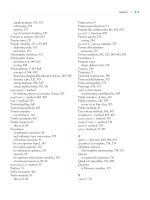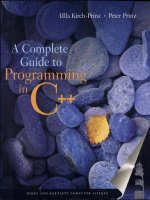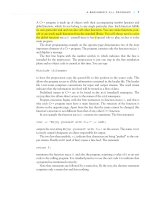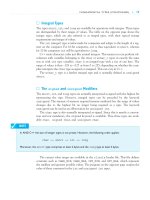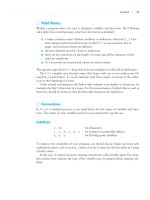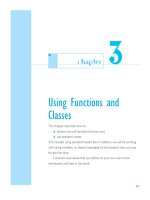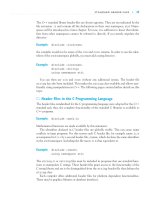A Complete Guide to Programming in C++ part 2 doc
Bạn đang xem bản rút gọn của tài liệu. Xem và tải ngay bản đầy đủ của tài liệu tại đây (198.47 KB, 10 trang )
discussed. Students learn that templates allow the construction of functions and classes
based on types that have not yet been stated. Thus, templates are a powerful tool for
automating program code generation.
Chapter 33 explains standard class templates used to represent containers for more
efficient management of object collections. These include sequences, such as lists and
double ended queues; container adapters, such as stacks, queues, and priority queues;
associative containers, such as sets and maps; and bitsets. In addition to discussing how
to manage containers, the chapter also looks at sample applications, such as bitmaps for
raster images, and routing techniques.
Additional Features
Chapter Goals A concise chapter introduction, which contains a description of the
chapter’s contents, is presented at the beginning of each chapter. These summaries also
provide students with an idea of the key points to look for throughout the chapter.
Chapter Exercises Each chapter contains exercises, including programming problems,
designed to test students’ knowledge and understanding of the main ideas. The exercises
also provide reinforcement for key chapter concepts. Solutions are included to allow
students to check their work immediately and correct any possible mistakes.
Case Studies Every chapter contains a number of case studies that were designed to
introduce the reader to a wide range of application scenarios.
Notes This feature provides students with helpful tips and information useful to learning
C++. Important concepts and rules are highlighted for additional emphasis and easy
access.
Hints These are informative suggestions for easier programming. Also included are
common mistakes and how to avoid making them.
Acknowledgements
Our thanks go out to everyone who helped produce this book, particularly to
Ian Travis, for his valuable contributions to the development of this book.
Alexa Doehring, who reviewed all samples and program listings, and gave many valuable
hints from the American perspective.
Michael Stranz and Amy Rose at Jones and Bartlett Publishers, who managed the pub-
lishing agreement and the production process so smoothly.
Our children, Vivi and Jeany, who left us in peace long enough to get things finished!
And now all that remains is to wish you, Dear Reader, lots of fun with C++!
Ulla Kirch-Prinz
Peter Prinz
PREFACE
■
ix
This page intentionally left blank
xi
Chapter 1 Fundamentals 1
Development and Properties of C++ 2
Object-Oriented Programming 4
Developing a C++ Program 6
A Beginner’s C++ Program 8
Structure of Simple C++ Programs 10
Exercises 12
Solutions 14
Chapter 2 Fundamental Types, Constants, and Variables 15
Fundamental Types 16
Constants 22
Escape Sequences 26
Names 28
Variables 30
The Keywords const and volatile 32
Exercises 34
Solutions 36
contents
Chapter 3 Using Functions and Classes 39
Declaring Functions 40
Function Calls 42
Type void for Functions 44
Header Files 46
Standard Header Files 48
Using Standard Classes 50
Exercises 52
Solutions 54
Chapter 4 Input and Output with Streams 57
Streams 58
Formatting and Manipulators 60
Formatted Output of Integers 62
Formatted Output of Floating-Point Numbers 64
Output in Fields 66
Output of Characters, Strings, and Boolean Values 68
Formatted Input 70
Formatted Input of Numbers 72
Unformatted Input/Output 74
Exercises 76
Solutions 78
Chapter 5 Operators for Fundamental Types 81
Binary Arithmetic Operators 82
Unary Arithmetic Operators 84
Assignments 86
Relational Operators 88
Logical Operators 90
Exercises 92
Solutions 94
Chapter 6 Control Flow 95
The while Statement 96
The for Statement 98
The do-while Statement 102
Selections with if-else 104
Else-if Chains 106
Conditional Expressions 108
Selecting with switch 110
Jumps with break, continue, and goto 112
Exercises 114
Solutions 116
xii
■
CONTENTS
Chapter 7 Symbolic Constants and Macros 119
Macros 120
Macros with Parameters 122
Working with the #define Directive 124
Conditional Inclusion 126
Standard Macros for Character Manipulation 128
Redirecting Standard Input and Output 130
Exercises 132
Solutions 134
Chapter 8 Converting Arithmetic Types 139
Implicit Type Conversions 140
Performing Usual Arithmetic Type Conversions 142
Implicit Type Conversions in Assignments 144
More Type Conversions 146
Exercises 148
Solutions 150
Chapter 9 The Standard Class string 153
Defining and Assigning Strings 154
Concatenating Strings 156
Comparing Strings 158
Inserting and Erasing in Strings 160
Searching and Replacing in Strings 162
Accessing Characters in Strings 164
Exercises 166
Solutions 168
Chapter 10 Functions 171
Significance of Functions in C++ 172
Defining Functions 174
Return Value of Functions 176
Passing Arguments 178
Inline Functions 180
Default Arguments 182
Overloading Functions 184
Recursive Functions 186
Exercises 188
Solutions 191
Chapter 11 Storage Classes and Namespaces 197
Storage Classes of Objects 198
The Storage Class extern 200
CONTENTS
■
xiii
The Storage Class static 202
The Specifiers auto and register 204
The Storage Classes of Functions 206
Namespaces 208
The Keyword using 210
Exercises 212
Solutions 216
Chapter 12 References and Pointers 221
Defining References 222
References as Parameters 224
References as Return Value 226
Expressions with Reference Type 228
Defining Pointers 230
The Indirection Operator 232
Pointers as Parameters 234
Exercises 236
Solutions 238
Chapter 13 Defining Classes 243
The Class Concept 244
Defining Classes 246
Defining Methods 248
Defining Objects 250
Using Objects 252
Pointers to Objects 254
Structs 256
Unions 258
Exercise 260
Solution 262
Chapter 14 Methods 265
Constructors 266
Constructor Calls 268
Destructors 270
Inline Methods 272
Access Methods 274
const Objects and Methods 276
Standard Methods 278
this Pointer 280
Passing Objects as Arguments 282
Returning Objects 284
Exercises 286
Solutions 290
xiv
■
CONTENTS
Chapter 15 Member Objects and Static Members 297
Member Objects 298
Member Initializers 300
Constant Member Objects 302
Static Data Members 304
Accessing Static Data Members 306
Enumeration 308
Exercises 310
Solutions 314
Chapter 16 Arrays 321
Defining Arrays 322
Initializing Arrays 324
Arrays 326
Class Arrays 328
Multidimensional Arrays 330
Member Arrays 332
Exercises 334
Solutions 338
Chapter 17 Arrays and Pointers 349
Arrays and Pointers (1) 350
Arrays and Pointers (2) 352
Pointer Arithmetic 354
Arrays as Arguments 356
Pointer Versions of Functions 358
Read-Only Pointers 360
Returning Pointers 362
Arrays of Pointers 364
Command Line Arguments 366
Exercises 368
Solutions 372
Chapter 18 Fundamentals of File Input and Output 379
Files 380
File Streams 382
Creating File Streams 384
Open Modes 386
Closing Files 388
Reading and Writing Blocks 390
Object Persistence 392
Exercises 394
Solutions 398
CONTENTS
■
xv
Chapter 19 Overloading Operators 411
Generals 412
Operator Functions (1) 414
Operator Functions (2) 416
Using Overloaded Operators 418
Global Operator Functions 420
Friend Functions 422
Friend Classes 424
Overloading Subscript Operators 426
Overloading Shift-Operators for I/O 428
Exercises 430
Solutions 432
Chapter 20 Type Conversion for Classes 441
Conversion Constructors 442
Conversion Functions 444
Ambiguities of Type Conversions 446
Exercise 448
Solution 450
Chapter 21 Dynamic Memory Allocation 453
The Operator new 454
The Operator delete 456
Dynamic Storage Allocation for Classes 458
Dynamic Storage Allocation for Arrays 460
Application: Linked Lists 462
Representing a Linked List 464
Exercises 466
Solutions 468
Chapter 22 Dynamic Members 477
Members of Varying Length 478
Classes with a Dynamic Member 480
Creating and Destroying Objects 482
Implementing Methods 484
Copy Constructor 486
Assignment 488
Exercises 490
Solutions 492
Chapter 23 Inheritance 499
Concept of Inheritance 500
Derived Classes 502
xvi
■
CONTENTS
Members of Derived Classes 504
Member Access 506
Redefining Members 508
Constructing and Destroying Derived Classes 510
Objects of Derived Classes 512
Protected Members 514
Exercises 516
Solutions 520
Chapter 24 Type Conversion in Class Hierarchies 529
Converting to Base Classes 530
Type Conversions and Assignments 532
Converting References and Pointers 534
Explicit Type Conversions 536
Exercises 538
Solutions 540
Chapter 25 Polymorphism 543
Concept of Polymorphism 544
Virtual Methods 546
Destroying Dynamically Allocated Objects 548
Virtual Method Table 550
Dynamic Casts 552
Exercises 554
Solutions 558
Chapter 26 Abstract Classes 565
Pure Virtual Methods 566
Abstract and Concrete Classes 568
Pointers and References to Abstract Classes 570
Virtual Assignment 572
Application: Inhomogeneous Lists 574
Implementing an Inhomogeneous List 576
Exercises 578
Solutions 580
Chapter 27 Multiple Inheritance 587
Multiply-Derived Classes 588
Multiple Indirect Base Classes 590
Virtual Base Classes 592
Constructor Calls 594
Initializing Virtual Base Classes 596
Exercises 598
Solutions 602
CONTENTS
■
xvii
Chapter 28 Exception Handling 607
Traditional Error Handling 608
Exception Handling 610
Exception Handlers 612
Throwing and Catching Exceptions 614
Nesting Exception Handling 616
Defining Your Own Error Classes 618
Standard Exception Classes 620
Exercises 622
Solutions 626
Chapter 29 More About Files 637
Opening a File for Random Access 638
Positioning for Random Access 640
File State 644
Exception Handling for Files 646
Persistence of Polymorphic Objects 648
Application: Index Files 652
Implementing an Index File 654
Exercises 656
Solutions 660
Chapter 30 More About Pointers 681
Pointer to Pointers 682
Variable Number of Arguments 684
Pointers to Functions 688
Complex Declarations 690
Defining Typenames 692
Application: Dynamic Matrices 694
Exercises 696
Solutions 698
Chapter 31 Manipulating Bits 705
Bitwise Operators 706
Bitwise Shift Operators 708
Bit Masks 710
Using Bit Masks 712
Bit-Fields 714
Exercises 716
Solutions 718
Chapter 32 Templates 721
Function and Class Templates 722
Defining Templates 724
xviii
■
CONTENTS
